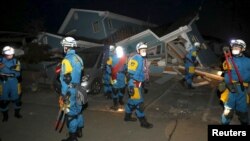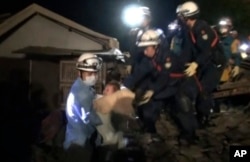Japan's Prime Minister Shinzo Abe has ordered more troops and disaster relief officials to the south of the country where two powerful earthquakes have struck over the span of two days.
Japan's news outlet NHK reported that 11 people died in the second quake Saturday morning near Kumamoto city, while another nine were killed in the initial tremor that hit the same region Thursday.
The Japan Meteorological Agency issued a tsunami warning for the western coast of the island of Kyushu after the latest quake, but canceled it a short time later.
Abe ordered troop reinforcements to the region to "concentrate the government's full capacity into the rescue, evacuation and lifesaving operations."
Some 1,600 soldiers are already mobilized in the region along with 2,000 police officers and 1,300 firefighters to help the area recover from the quakes.
The two quakes toppled buildings and also caused a large fire at an apartment complex in Yatsushiro city. Officials say they fear more people are trapped or buried beneath the rubble of buildings.
One bright spot was the televised rescue of a baby who was carried out of the debris of a collapsed home.
Aftershocks
More than 100 aftershocks have occurred since Thursday's 6.5-magnitude earthquake.
Seismologist Robert Geller, a professor of geophysics at Tokyo University, told VOA that the powerful series of quakes in Kumamoto prefecture is not uncommon.
"For example, there was a magnitude 7.3 quake two days before the magnitude 9.0 [or maybe 9.1] Tohoku quake in 2011," he said.
Water service has been disrupted in some areas, forcing residents to haul water from local offices to their homes.
A Kumamoto official said about 44,000 people spent the night in shelters after fleeing their homes.
Government spokesman Yoshihide Suga said there were no apparent abnormalities at nearby nuclear facilities. The epicenter of the first quake was about 120 kilometers northeast of the country's only operating nuclear plant.
Most of Japan's other nuclear reactors remain offline after a 9.0 magnitude earthquake in 2011 triggered a huge tsunami.
Correspondent Steve Herman contributed to this report.












